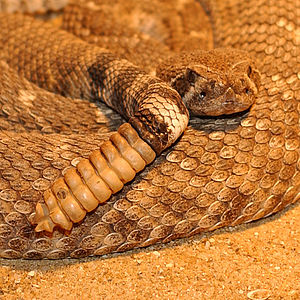| Modified tail scales form a rattle on a Western Diamondback Rattlesnake Crotalus atrox. (Photo credit: Wikipedia) |
The most
unique characteristic of a rattlesnake is its rattle. When born, they have what
is called a “prebutton,” which is lost the first time the snake sheds its skin.
At that them the prebutton is replaced by a button. Each time a rattlesnake
sheds its skin, which is one to four times a year, anther button or segment is
added to the rattle. So, when snakes are very young, they can’t rattle, because
it takes at least two buttons to make a rattle sound. These buttons aren’t like
a baby rattle, either. There is nothing inside of them. Instead, the rattle
sound is generated by the buttons make contact with each other. This sound,
which is enough to alert someone standing even at some distance, is generated
by the snake’s tail moving back and forth 60 or more times per second.
 |
| Rattlesnake rattles (Photo credit: Wikipedia) |
The rattle
is composed of keratin, the same stuff that forms our fingernails. Because of
this, the buttons composing the rattle can break off. That is why a rattlesnake
is constantly replacing the rattles when it sheds.
 |
| Western diamondback rattlesnake (Crotalus atrox). (Photo credit: Wikipedia) |
Adult rattlesnakes
vary in length, ranging from 1.5 feet up to eight feet. Their colors vary by
species, while the usually have diamond or hexagon shaped blotches on their
skin.
How they
sense prey or an enemy is through sensory organs located behind each nostril is
a heat sensing pit. These pits can detect differences in temperature from
several yards away. It is said that these animals can detect heat from a lit
candle at a distance of 30 feet.
Their eyes also
sense heat by seeing in infrared. This helps them hunt at night, when vision is
impaired by darkness. The larger an animal, the more heat it gives off, letting
the snake whether it should tangle with an animal or hide.
When a
rattler bites, its fangs act as hypodermic syringes, ejecting a mix of enzymes
into its prey. These enzymes destroy blood and paralyze nerves.
Being
cold blooded, rattlesnakes are more active from the period from spring through
fall, because that is when temperatures are at their greatest. Rattlesnakes are
most often seen when temperatures are between 70 and 90 degrees, regardless of
the time of day or time of year.
 |
| English: watch for rattlesnakes sign (Photo credit: Wikipedia) |
If you
do happen to walk along the shores of the Deschutes River in flip-flops and are
bit, it is suggested you do the following:
*Try to
remain calm.
*Keep
your heart from beating faster by lying down if you can. Obviously, if you are
alone, you need to find help.
*Keep a
bitten limb lower than your heart.
*Wash
the wound gently with soap and water.
*Remove
anything that will constrict swelling, like watches, rings, bracelets or other jewelry.
*Do not
try to suck out the venom.
*Get
medical help as soon as possible.
Another
interesting factoid is even when a rattler is dead it can still bite by way of
a reflex action. Even a snakes head when removed from the body can bite.
It is
suggested that after you kill a rattlesnake, remove its head with a shovel and
bury it. Yellow jackets will feed on a dead snake if left above the ground. If they
ingest the venom and sting someone, the venom can be released into a person’s
blood stream.
Here is
a little episode that happened a few days ago. A Southern California teenage
girl was bitten by rattlesnakes at least six times after climbing a hill in San
Diego in search of a cellphone signal.
She
said she heard rattlesnakes all over and attempted to run back to her uncle’s
house, but stepped on a nest of the snakes. Apparently, she blacked out but
made it back to her uncle’s home. Her uncle took her to a local hospital after
she had tied a tourniquet around her leg.
You
should never tie a tourniquet around a limb after being bitten by a
rattlesnake. Furthermore, the uncle tried to suck the venom out of the wounds,
which is a no-no. The human saliva can infect a wound. Also, never put ice on
the area that is bitten.
The
girl remained in the intensive care unit of the hospital for four days and
received 24 vials of antivenom. She is expected to make a full recovery.
This
jokes on me:
It’s an
oldy but goody: The Lone Ranger and Tonto were out and about when the Lone Ranger
was bitten on the butt by a rattlesnake. Knowing not what to do, the Lone
Ranger told Tonto to go to town to ask the doctor what to do.
The
doctor told Tonto he needed to suck the poison out the wound or the Lone Ranger
would die.
When
Tonto returned, the Lone Ranger asked Tonto what the doctor had said. Tonto
told the Lone Ranger, “You’re gonna die.”




